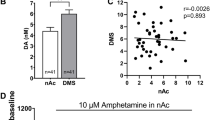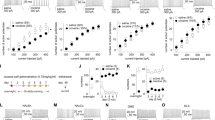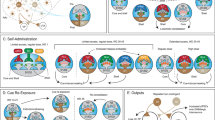Abstract
Amphetamine maintenance is effective clinically to reduce the consumption of the monoamine uptake inhibitor cocaine but not of the monoamine releaser methamphetamine, and its effectiveness in treating the abuse of other psychostimulants is not known. The mechanisms for differential amphetamine-maintenance effectiveness to treat different types of psychostimulant abuse are also not known. Accordingly, the present study compared the effects of amphetamine maintenance on abuse-related behavioral and neurochemical effects of cocaine, methamphetamine, and the “bath salts” constituent 3,4-methylenedioxypyrovalerone (MDPV) in rats. In behavioral studies, rats were trained to lever press for electrical brain stimulation in an intracranial self-stimulation (ICSS) procedure. In neurochemical studies, nucleus accumbens (NAc) levels of dopamine (DA) and serotonin (5-HT) were monitored by in vivo microdialysis. Cocaine, methamphetamine, and MDPV each produced dose-dependent ICSS facilitation and increases in NAc DA; cocaine and methamphetamine also increased NAc 5-HT. Amphetamine maintenance (0.32 mg/kg/h × 7 days) produced (1) sustained increases in basal ICSS and NAc DA with no change in NAc 5-HT, (2) blockade of cocaine but not methamphetamine effects on ICSS and NAc DA, and (3) no blockade of cocaine- or methamphetamine-induced increases in NAc 5-HT. Amphetamine maintenance blocked the increases in NAc DA produced by the selective DA uptake inhibitor MDPV, but it did not block MDPV-induced ICSS facilitation. These results show different effects of amphetamine maintenance on behavioral and neurochemical effects of different psychostimulants. The selective effectiveness of amphetamine maintenance to treat cocaine abuse may reflect attenuation of cocaine-induced increases in NAc DA while preserving cocaine-induced increases in NAc 5-HT.
Similar content being viewed by others
Log in or create a free account to read this content
Gain free access to this article, as well as selected content from this journal and more on nature.com
or
References
SAMSHA, 2017: Substance Abuse and Mental Health Services Administration. (2017). Key substance use and mental health indicators in the United States: Results from the 2016 National Survey on Drug Use and Health (HHS Publication No. SMA 17-5044, NSDUH Series H-52). Rockville, MD: Center for Behavioral Health Statistics and Quality, Substance Abuse and Mental Health Services Administration. Retrieved from https://www.samhsa.gov/data/
Karila L, Lafaye G, Scocard A, Cottencin O, Benyamina A. MDPV and α-PVP use in humans: the twisted sisters. Neuropharmacology. 2017:1–8. https://doi.org/10.1016/j.neuropharm.2017.10.007.
Rothman RB, Baumann MH. Balance between dopamine and serotonin release modulates behavioral effects of amphetamine-type drugs. Ann N Y Acad Sci. 2006;1074:245–60.
Bauer CT, Banks ML, Blough BE, Negus SS. Use of intracranial self-stimulation to evaluate abuse-related and abuse-limiting effects of monoamine releasers in rats. Br J Pharmacol. 2013;168:850–62.
Suyama JA, Sakloth F, Kolanos R, Glennon RA, Lazenka MF, Negus SS, et al. Abuse-related neurochemical effects of para-substituted methcathinone analogs in rats: microdialysis studies of nucleus accumbens dopamine and serotonin. J Pharmacol Exp Ther. 2016;356:182–90.
Wee S, Anderson KG, Baumann MH, Rothman RB, Blough BE, Woolverton WL. Relationship between the serotonergic activity and reinforcing effects of a series of amphetamine analogs. J Pharmacol Exp Ther. 2005;313:848–54.
De Felice LJ, Glennon RA, Negus SS. Synthetic cathinones: chemical phylogeny, physiology, and neuropharmacology. Life Sci. 2014;97:20–26.
Rothman RB, Baumann MH, Dersch CM, Romero DV, Rice KC, Carroll FIVY, et al. Amphetamine-type central nervous norepinephrine more potently than they release dopamine and serotonin. Synapse. 2001;39:32–41.
Castelles X, Cunill R, Pérez-Mañá C, Vidal X, Capellà D. (2016). Psychostimulant drugs for cocaine dependence. Cochrane Database Syst Rev. 2016;27:CD007380.
Grabowski J, Rhoades H, Schmitz J, Stotts A, Daruzska LA, Creson D, et al. Dextroamphetamine for cocaine-dependence treatment: a double-blind randomized clinical trial. J Clin Psychopharmacol. 2001;21:522–6.
Greenwald MK, Lundahl LH, Steinmiller CL. Sustained release d-amphetamine reduces cocaine but not “speedball”-seeking in buprenorphine-maintained volunteers: a test of dual-agonist pharmacotherapy for cocaine/heroin polydrug abusers. Neuropsychopharmacology. 2010;35:2624–37.
Levin FR, Mariani JJ, Specker S, Mooney M, Mahony A, Brooks DJ, et al. Extended-release mixed amphetamine salts vs. placebo for comorbid adult attention-deficit/hyperactivity disorder and cocaine use disorder. JAMA Psychiatry. 2015;72:593–602.
Schmitz JM, Rathnayaka N, Green CE, Moeller FG, Dougherty AE, Grabowski J. Combination of modafinil and d-amphetamine for the treatment of cocaine dependence: a preliminary investigation. Front Psychiatry. 2012;3:1–6.
Banks ML, Pharm D, Hutsell BA, Blough BE, Poklis JL, Stevens Negus S. Preclinical assessment of lisdexamfetamine as an agonist medication candidate for cocaine addiction: effects in rhesus monkeys trained to discriminate cocaine or to self-Administer cocaine in a cocaine versus food choice procedure. Int J Neuropsychopharmacol. 2015;18:1–10.
Rush CR, Stoops WW, Sevak RJ, Hays LR. Cocaine choice in humans during D-amphetamine maintenance. J Clin Psychopharmacol. 2010;30:152–9.
Thomsen M, Barrett AC, Negus SS, Caine SB. Cocaine versus food choice procedure in rats: environmental manipulations and effects of amphetamine. J Exp Anal Behav. 2013;99:211–33.
Galloway GP, Buscemi R, Coyle JR, Flower K, Siegrist JD, Fiske LA, et al. A randomized, placebo-controlled trial of sustained-release dextroamphetamine for treatment of methamphetamine addiction. Clin Pharmacol Ther. 2011;89:276–82.
Schwienteck KL, Banks ML. Effects of 7-day continuous d-amphetamine, methylphenidate, and cocaine treatment on choice between methamphetamine and food in male rhesus monkeys. Drug Alcohol Depend. 2015;155:16–23.
Grabowski J, Rhoades H, Stotts A, Cowan K, Kopecky C, Dougherty A. et al. Agonist-like or antagonist-like treatment for cocaine dependence with methadone for heroin dependence: two double-blind randomized clinical trials. Neuropsychopharmacology. 2004;29:969–81.
Rothman RB, Blough BE, Baumann MH. Appetite suppressants as agonist substitution therapies for stimulant dependence. Ann N Y Acad Sci. 2002;965:109–26.
Tomasiewicz HC, Todtenkopf MS, Chartoff EH, Cohen BM, Carlezon WA Jr. The kappa-opioid agonist U69,593 blocks cocaine-induced enhancement of brain stimulation reward. Biol Psychiatry. 2008;64:982–8.
Negus SS, Miller LL. Intracranial self-stimulation to evaluate abuse potential of drugs. Pharmacol Rev. 2014;66:869–917.
Bauer CT, Banks ML, Negus SS. The effect of chronic amphetamine treatment on cocaine-induced facilitation of intracranial self-stimulation in rats. Psychopharmacology (Berl). 2014;231:2461–70.
Negus SS, Banks ML. Decoding the structure of abuse potential for new psychoactive substances: structure--activity relationships for abuse-related effects of 4-substituted methcathinone analogs. Curr Top Behav Neurosci. 2017;32:119–31.
Boudanova E, Navaroli DM, Melikian HE. Amphetamine-induced decreases in dopamine transporter surface expression are protein kinase C-independent. Neuropharmacology. 2008;54:605–12.
German CL, Baladi MG, McFadden LM, Hanson GR, Fleckenstein AE. Regulation of the dopamine and vesicular monoamine transporters: pharmacological targets and implications for disease. Pharmacol Rev. 2015;67:1005–24.
Bonano JS, Glennon RA, De FeliceLJ, Banks ML, Negus SS. Abuse-related and abuse-limiting effects of methcathinone and the synthetic “bath salts” cathinone analogs methylenedioxypyrovalerone (MDPV), methylone and mephedrone on intracranial self-stimulation in rats. Psychopharmacology (Berl). 2014;231:199–207.
Pereira Do Carmo G, Stevenson GW, Carlezon WA, Negus SS. Effects of pain- and analgesia-related manipulations on intracranial self-stimulation in rats: further studies on pain-depressed behavior. Pain. 2009;144:170–7.
Bonano JS, Runyon SP, Hassler C, Glennon RA, Negus SS. Effects of the neuropeptide S receptor antagonist RTI-118 on abuse-related facilitation of intracranial self-stimulation produced by cocaine and methylenedioxypyrovalerone (MDPV) in rats. Eur J Pharmacol. 2014;743:98–105.
Kuhar MJ, McGirr KM, Hunter RG, Lambert PD, Garrett BE, Carroll FI. Studies of selected phenyltropanes at monoamine transporters. Drug Alcohol Depend. 1999;56:9–15.
Andrews CM, Lucki I. Effects of cocaine on extracellular dopamine and serotonin levels in the nucleus accumbens. Psychopharmacology (Berl). 2001;155:221–9.
Schindler CW, Thorndike EB, Goldberg SR, Lehner KR, Cozzi NV, Brandt SD, et al. Reinforcing and neurochemical effects of the “bath salts” constituents 3,4-methylenedioxypyrovalerone (MDPV) and 3,4-methylenedioxy-N-methylcathinone (methylone) in male rats. Psychopharmacology (Berl). 2016;233:1981–90.
Baumann MH, Ayestas MA, Partilla JS, Sink JR, Shulgin AT, Daley PF, et al. The designer methcathinone analogs, mephedrone and methylone, are substrates for monoamine transporters in brain tissue. Neuropsychopharmacology. 2012;37:1192–203.
Aarde SM, Huang PK, Creehan KM, Dickerson TJ, Taffe MA. The novel recreational drug 3,4-methylenedioxypyrovalerone (MDPV) is a potent psychomotor stimulant: self-administration and locomotor activity in rats. Neuropharmacology. 2013;71:130–40.
Gannon BM, Galindo KI, Rice KC, Collins GT. Individual differences in the relative reinforcing effects of 3,4-methylenedioxypyrovalerone under fixed and progressive ratio schedules of reinforcement in rats. J Pharmacol Exp Ther. 2017;361:181–9.
Watterson LR, Kufahl PR, Nemirovsky NE, Sewalia K, Grabenauer M, Thomas BF, et al. Potent rewarding and reinforcing effects of the synthetic cathinone 3,4-methylenedioxypyrovalerone (MDPV). Addict Biol. 2014;19:165–74.
Lazenka MF, Blough BE, Negus SS. Preclinical Abuse potential assessment of flibanserin: effects on intracranial self-stimulation in female and male rats. J Sex Med. 2016;13:338–49.
Negus SS, Banks ML (2017). Decoding the structure of abuse potential for new psychoactive substances: structure--activity relationships for abuse-related effects of 4-substituted methcathinone analogs. Curr Top Behav Neurosci. 2017;32:119–31. http://doi.org/10.1007/7854_2016_18.
Bauer CT, Banks ML, Blough BE, Negus SS. Role of 5-HT2C receptors in effects of monoamine releasers on intracranial self-stimulation in rats. Psychopharmacology (Berl). 2015;232:3249–58.
Baumann MH, Clark RD, Woolverton WL, Wee S, Blough BE, Rothman RB. In vivo effects of amphetamine analogs reveal evidence for serotonergic inhibition of mesolimbic dopamine transmission in the rat. J Pharmacol Exp Ther. 2011;337:218–25.
Chiodo KA, Läck CM, Roberts DCS. Cocaine self-administration reinforced on a progressive ratio schedule decreases with continuous D-amphetamine treatment in rats. Psychopharmacology (Berl). 2008;200:465–73.
Siciliano CA, Saha K, Calipari ES, Fordahl SC, Chen R, Khoshbouei H, Jones SR. Amphetamine reverses escalated cocaine intake via resortation of dopamine transporter conformation. J Neurosci. 2018;38:484–97.
Grabowski J, Shearer J, Merrill J, Negus SS. Agonist-like, replacement pharmacotherapy for stimulant abuse and dependence. Addict Behav. 2004b;29:1439–64.
Negus SS, Henningfield J. Agonist medications for the treatment of cocaine use disorder. Neuropsychopharmacology. 2015;40:1815–25.
Rosenberg MB, Carroll FI, Negus SS. Effects of monoamine reuptake inhibitors in assays of acute pain-stimulated and pain-depressed behavior in rats. J Pain. 2013;14:246–59.
Roberts DCS, Phelan R, Hodges LM, Hodges MM, Bennett B, Childers S, et al. Self-administration of cocaine analogs by rats. Psychopharmacology (Berl). 1999;144:389–97.
Simmler LD, Buser TA, Donzelli M, Schramm Y, Dieu LH, Huwyler J, et al. Pharmacological characterization of designer cathinones in vitro. Br J Pharmacol. 2013;168:458–70.
Baumann MH, Partilla JS, Lehner KR, Thorndike EB, Hoffman AF, Holy M, et al. Powerful cocaine-like actions of 3,4-methylenedioxypyrovalerone (MDPV), a principal constituent of psychoactive “ bath salts” products. Neuropsychopharmacology. 2013;38:552–62.
Lazenka MF, Legakis LP, Stevens Negus S. Opposing effects of dopamine D1-and D2-Like agonists on intracranial self-stimulation in male rats. Exp Clin Psychopharmacol. 2016;24:193–205.
Jones SR, Joseph JD, Barak LS, Caron MG, Wightman RM. Dopamine neuronal transport kinetics and effects of amphetamine. J Neurochem. 1999;73:2406–14.
Acknowledgements
The research reported in this publication was supported by the National Institute on Drug Abuse of the National Institutes of Health under Award Number R01 DA033930 and T32 DA007027. The content is solely the responsibility of the author and does not necessarily represent the official views of the National Institutes of Health.
Author contributions
ARJ conducted all the experiments, the initial graphing and analysis of all the data, and drafted the text. MLB supervised the microdialysis studies, SSN supervised the ICSS studies, and DES supervised the receptor binding studies. MLB, SSN, and DES contributed to the experimental design and generation of final data analysis, graphs, and text. All authors approved the final text.
Author information
Authors and Affiliations
Corresponding author
Ethics declarations
Competing interests
The authors declare no competing interests.
Electronic supplementary material
Rights and permissions
About this article
Cite this article
Johnson, A.R., Banks, M.L., Selley, D.E. et al. Amphetamine maintenance differentially modulates effects of cocaine, methylenedioxypyrovalerone (MDPV), and methamphetamine on intracranial self-stimulation and nucleus accumbens dopamine in rats. Neuropsychopharmacol 43, 1753–1762 (2018). https://doi.org/10.1038/s41386-018-0071-3
Received:
Revised:
Accepted:
Published:
Issue date:
DOI: https://doi.org/10.1038/s41386-018-0071-3
This article is cited by
-
Rate of onset of dopamine transporter inhibitors assessed with intracranial self-stimulation and in vivo dopamine photometry in rats
Psychopharmacology (2023)
-
Amphetamine maintenance therapy during intermittent cocaine self-administration in rats attenuates psychomotor and dopamine sensitization and reduces addiction-like behavior
Neuropsychopharmacology (2021)
-
Intracranial self-stimulation and concomitant behaviors following systemic methamphetamine administration in Hnrnph1 mutant mice
Psychopharmacology (2021)
-
Temporal parameters of enhanced opioid reward after initial opioid exposure in rats
Psychopharmacology (2021)
-
Effects of repeated treatment with methcathinone, mephedrone, and fenfluramine on intracranial self-stimulation in rats
Psychopharmacology (2019)



